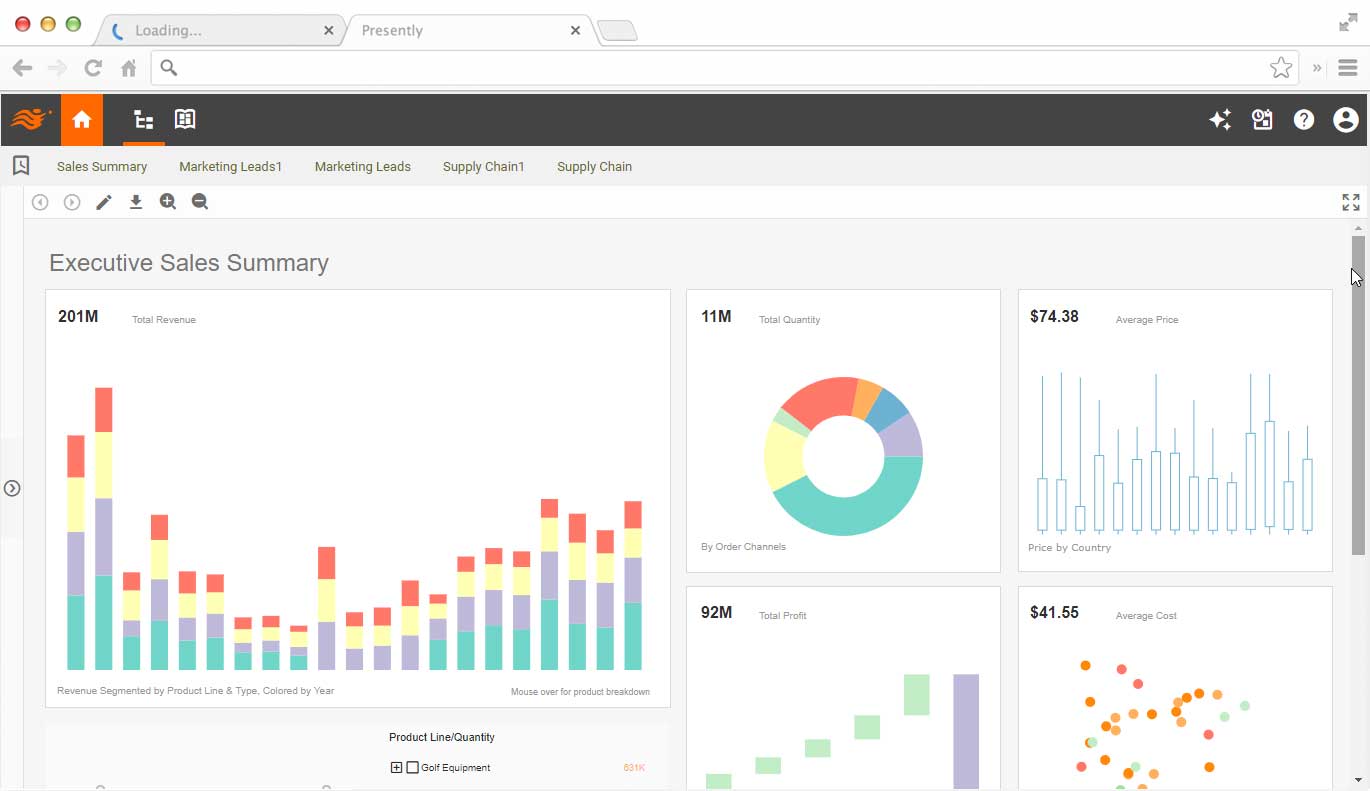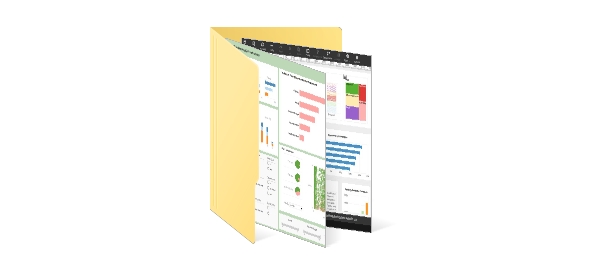Self-Service Sales Dashboards and Opportunity Discovery
Management and sales professionals normally depend on professionally-built visualization dashboards and reports for their known business needs. However, no design can anticipate all business questions.
Flexible interactivity and ad hoc customization by end users becomes essential for quick business decisions. InetSoft's solution allows not only visual manipulation but also governed access to underlying data.

Data Mashup for Holistic Customer Views
Just like CRM systems, other software such as order management and call center software are also being offered as Software-As-A-Service. And long established and trusted on-premise software are still important for customer related assets. Third party data such as social media often are also critical in understanding customers. InetSoft's web app enables data-oriented sales operations analysts to rapidly mashup this variety of data and extract intelligence that will improve sales effectiveness and maximize cross selling.
Machine Learning Enhanced Sales Insight
Machine learning finds hidden information and patterns in data. It perfectly complements human-extracted information. For example, different customer cohorts many times exhibit different behavior. Machine learning can bring unique ways to identify customer cohorts to minimize customer churn. With InetSoft's solution, sales professionals can drive machine learning processes directly through interactive dashboards which mashup human-designed visualizations with machine-driven outputs.
Upgrading Sales Dashboards: An Illumination Optics Fabricator Moves from Phocas to StyleBI
For a specialized Illumination Optics Fabricator — a company that produces precision lenses, reflectors, and custom light-guiding components for medical, aerospace, and theatrical applications — the sales function is both art and science. Salespeople must translate complex technical specifications, long lead times, and bespoke pricing into firm quotes and predictable revenue. When that fabricator moves its sales analytics from Phocas to StyleBI, the migration isn’t just a product swap: it’s a chance to rethink how commercial intelligence supports engineering cycles, quoting accuracy, and profitable growth.
First, let’s be blunt: Phocas does a lot well for traditional sales reporting — it’s solid for static scorecards, simple drilldowns, and business-user self-service. But an optics fabricator often needs more specialized views: quote-configurator integration, BOM-aware deal profitability, sample lifecycle tracking, and high-fidelity lead-time forecasting that ties sales activity to shop floor constraints. StyleBI’s strengths — embeddable analytics, flexible data modeling, and dashboard components tailored to product complexity — let the company take sales insight one level deeper, from “what happened” to “what will happen if we commit to this build.”
Technically the upgrade has three pillars: data model redesign, dashboard UX tailored to sales workflows, and tighter integration with operational sources. The data model must unify CRM opportunities, ERP orders, engineering change logs, and shop-floor MRP outputs. This means mapping multi-level BOMs, routing times, and external supplier lead times into a dataset that sales dashboards can query in near-real-time. StyleBI’s metadata-driven semantic layer makes it easier to expose those relationships to end users without forcing them to learn SQL — a clear win in a company where engineers and sales reps share data but speak different languages.
UX matters here more than in many commoditized B2B settings. A fabricator’s quoting process needs an interactive dashboard where a salesperson can toggle lens coatings, change tolerances, and immediately see the impact on cost, lead-time, and margin. StyleBI’s widget set and embeddable controls allow the company to build interactive configurator panels embedded next to the sales funnel. Rather than a static “margin” number, the rep sees margin ranges, risk flags (e.g., single-source vendor for a critical substrate), and a suggested up-charge for expedited runs. That interactivity shortens cycles and reduces overstated promises to customers.
Another big benefit is visibility into work-in-progress and its effect on promise dates. Phocas is excellent for historical analysis but less rich in continuous operational telemetry. StyleBI connects to streaming or frequent-polling feeds from MES and MRP systems so the sales dashboard can flag when a critical machine is down, when a supplier shipment is delayed, or when a batch has failed QC. For sales, this translates to proactive communications: instead of apologizing for a late delivery, the rep can offer alternatives earlier and preserve customer trust — a difference that matters enormously in the high-value, low-volume world of custom optics.
From a governance and IT perspective, the migration is an opportunity to rationalize metrics and reduce shadow reporting. In many fabricators, different sales teams maintain divergent spreadsheets for sample costs, expedited fees, and warranty reserves. StyleBI supports a governed semantic layer where “cost to manufacture” and “expected lead time” are defined once and surfaced everywhere uniformly. That reduces disputes between sales and operations, and makes executive dashboards trustworthy. The IT team can also centralize authentication, SSO, and row-level security so sensitive pricing information is visible only to authorized roles.
Change management deserves an explicit paragraph: people are the real project risk. Sales reps accustomed to Phocas’ simple drilldowns may initially resist more interactive capabilities if they perceive them as slower to use. The implementation should therefore begin with a small pilot team of power users who co-design a set of “sales moment” dashboards — quoting, backlog reconciliation, and capacity-aware pipeline. Training should emphasize time-savers: one-click margin sensitivity, automated quote attachments, and integrated sample-status views. Quick wins build momentum and convert skeptics into champions.
Measuring success is straightforward if you pick the right KPIs. Track quote-to-order conversion rate, average quote cycle time, forecast accuracy for committed orders, on-time delivery versus promise date, and margin variance by product family and customer. Beyond those, monitor softer adoption metrics: percentage of reps using the configurator, dashboards accessed per week, and number of manual spreadsheet uploads eliminated. Within six months, the fab should be able to show reduced quoting time, fewer expedited jobs, and improved gross margins on bespoke work — the commercial proof that the technical migration paid off.
Cost and licensing are practical realities. StyleBI typically offers more flexibility for embedding analytics into internal tools and customer portals, and that capability can unlock revenue opportunities (e.g., shared dashboards for strategic OEMs). The fabricator should build a rolling ROI model: consider reduced sales cycle costs, fewer late-delivery penalties, and labor reclaimed from manual reporting. Factor in one-time migration costs (data modeling, ETL rework, dashboard redesign) and ongoing maintenance. My opinion: for a vendor of complex, high-margin custom components, the long-term ROI for a platform that ties sales to operational reality is usually compelling.
Finally, think strategically: this upgrade can be a platform for future capabilities. Embedded analytics can be exposed to strategic customers as value-added services — customers that can see sample status or projected ship dates tend to be stickier. Predictive analytics can later be layered on to estimate lead-time variability or the probability of rework, allowing sales to price risk proactively. In short, moving from Phocas to StyleBI is more than a tooling change; for an Illumination Optics Fabricator it’s an investment in a sales operating model that treats knowledge as a differentiator and operational transparency as competitive advantage.



